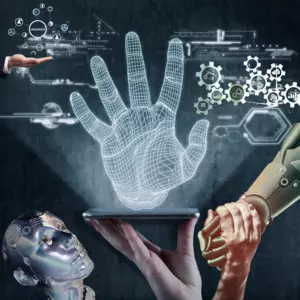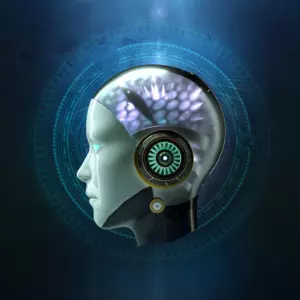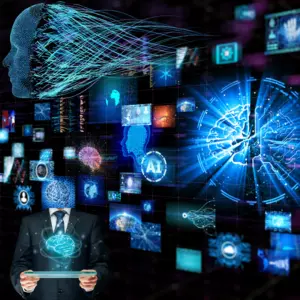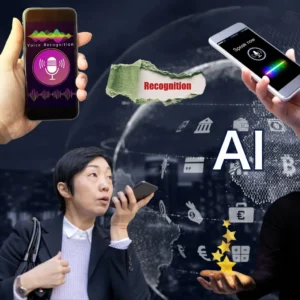
Chatbots to Culture
AI in language learning apps
In the dynamic realm of education, where language acquisition stands as a cornerstone of global connectivity, the integration of AI has sparked a revolution.
Welcome to “Chatbots to Culture: AI’s Hand in Mastering Languages.” This article delves into the captivating landscape of AI implementation within language learning.
We uncover how AI is reshaping the language acquisition landscape, from harnessing AI-driven language apps and perfecting accents with Machine Learning to immersive linguistic games and predictive analytics shaping individual trajectories.
Join us in exploring how AI unveils new horizons in personalized language courses, real-time practice through chatbots, and the mesmerizing wonders of real-time translation.
Embark on a journey through the synergies of AI and linguistics, celebrating multilingual successes and envisioning the intriguing future of AI-driven polyglotism.
Table of Contents

Arindam Roy
An Automation Consultant with 25+ years of IT Experience
Dive into AI-powered language apps
Embarking on a linguistic journey has never been more engaging, thanks to AI-powered language learning apps. These technological marvels bring forth a fusion of personalized learning experiences and advanced language acquisition techniques.
Through adaptive algorithms, these apps tailor content to individual proficiency levels, ensuring an optimal challenge. AI’s real-time feedback refines pronunciation and grammar, while interactive exercises captivate learners.
These apps transform education into an immersive adventure by seamlessly integrating multimedia resources and gamified elements. From Duolingo’s gamified lessons to Babbel’s speech recognition, AI breathes life into language learning, propelling learners toward fluency while fostering a passion for global communication.
Engaging Linguistic Games
Learning a language becomes an exhilarating venture with the infusion of AI-driven interactive language games. These captivating tools make language acquisition enjoyable and effective. Gamification techniques enhance engagement by transforming lessons into playful challenges.
These games cater to diverse learning styles, from vocabulary quizzes that feel like adventures to grammar puzzles that unravel like mysteries. AI adapts the game’s difficulty based on progress, maintaining an optimal level of challenge.
Memrise, for instance, employs spaced repetition and mnemonic techniques, harnessing AI to make vocabulary retention a joyful endeavour. As education becomes entertainment, linguistic games pave the way for profound language proficiency.
Monitoring Language Learning Trajectories
Predictive analytics unfurl a new educational dimension by meticulously tracking language learning trajectories. AI-powered systems gather data on individual progress, identifying strengths and areas that need focus.
These insights enable educators and learners to tailor strategies for optimal results. Duolingo’s data-driven approach maps user proficiency, estimating time to fluency. Through comprehensive analytics, educators can refine curriculum and adapt teaching methodologies.
This personalized guidance ensures that learners stay on the path to success. With AI as a compass, language learning trajectories become finely tuned, transforming the journey into a well-guided expedition toward linguistic mastery.
AI-driven Virtual Trips and Cultural Immersion
Embarking on a language-learning odyssey takes a remarkable turn with AI-driven virtual trips and cultural immersion. Learners teleport to foreign locales through immersive simulations, engaging with native speakers and authentic scenarios.
AI-generated environments foster real-world conversations, enhancing linguistic skills within cultural contexts. Apps like FluentU offer curated video content with interactive subtitles, transforming passive viewing into active learning.
AI refines content recommendations based on proficiency, ensuring a seamless yet challenging experience. Virtual cultural adventures coupled with language acquisition redefine education, whisking learners away on a global exploration from the comfort of their screens.
Customizing Language Lessons
AI ushers in a new era of personalized language courses, tailoring education to individual needs. AI identifies learners’ strengths, weaknesses, and learning preferences through data analysis, shaping lessons accordingly.
Platforms like Babbel employ AI to design custom curricula, adapting content in real-time to optimize comprehension. Learners can focus on specific conversational, business-oriented, or academic skills. Before moving on to new concepts, adaptive quizzes ensure that the previously learned concepts are thoroughly understood and retained.
This strengthens the foundation of knowledge and promotes successful learning outcomes. As AI becomes the ultimate tutor, it revolutionizes education, enabling learners to embark on a transformative language journey catered to their unique aspirations and capabilities.
In the future, individuals will achieve fluency in language through precision-guided learning in customized language lessons. I have corrected any spelling, grammar, or punctuation errors in the original text to ensure that it is straightforward to read.
Practicing with AI Chatbots
Real-time language practice receives a cutting-edge makeover through AI-driven chatbots. These conversational companions simulate human interactions, providing a safe space to refine language skills. Whether honing everyday conversations or mastering complex dialogues, learners engage in authentic exchanges with instant feedback.
AI chatbots, like those integrated into platforms such as Tandem and HelloTalk, adapt to learners’ proficiency levels, offering tailored challenges. Learners overcome hesitation while practising in a pressure-free environment, bolstering confidence and fluency.
With AI chatbots as constant conversation partners, language learners step into a world of endless dialogue possibilities, transforming practice into a joyful journey.
Real-time Translation Wonders
The language barrier crumbles in the wake of AI-enhanced language translation tools, revolutionizing global communication. Real-time translation apps, like Google Translate, employ neural networks to decipher and interpret spoken and written content seamlessly.
Travellers, students, and professionals wield these tools for instant comprehension, fostering cross-cultural interactions. AI’s context-aware algorithms ensure accuracy by considering nuances and idiomatic expressions.
The convergence of AI and translation empowers individuals to explore foreign lands, connect with diverse communities, and engage with multilingual content effortlessly. In an interconnected world, real-time translation is a testament to AI’s transformative impact on linguistics.
Celebrating Multilingual Successes with AI
AI-driven language learning journeys yield remarkable multilingual successes, fostering global citizens. Through AI’s guidance, learners achieve fluency in multiple languages, transcending barriers.
Innovative platforms, like Rosetta Stone, recognize achievements and milestones, encouraging learners to celebrate their linguistic triumphs. AI’s data-driven insights highlight progress, empowering learners with tangible evidence of their growth.
Whether mastering French, Mandarin, or Spanish, AI paves the way for a polyglot society. As individuals revel in their multilingual prowess, AI redefines education by shaping individuals who can seamlessly traverse linguistic landscapes, embodying the potential of technology-driven language mastery.
Perfecting Accents with ML
Mastery of a language goes beyond words; it’s about capturing the nuances of pronunciation and tone. Machine Learning (ML) comes to the forefront in accent training, offering a revolutionary approach to perfecting accents.
ML algorithms analyze speech patterns, identifying subtle deviations from native accents. Through personalized exercises and auditory comparisons, learners receive targeted guidance. ML’s adaptability ensures that as accents evolve, so does the training.
Companies like Rosetta Stone utilize ML to provide an immersive accent improvement experience. ML is a valuable tool in pursuing linguistic authenticity, guiding learners toward flawless intonation and articulation.
The Next Wave in AI-driven Linguistics
The horizon of AI-driven linguistics is ablaze with possibilities, poised to reshape language learning profoundly. As AI advances, its integration with linguistic expertise promises breakthroughs beyond the current imagination.
Virtual reality language immersion, emotion-sensitive language feedback, and even neural interfaces for direct communication are on the horizon. AI’s understanding of context, cultural nuances, and emotional undertones will unlock language’s true essence.
The synergy between AI and linguistics lays the foundation for a future where language barriers crumble, understanding deepens, and global communication reaches unprecedented heights.
Conclusion
The fusion of AI and language learning has ushered in an era of transformative possibilities. From AI-powered apps customizing lessons to chatbots enabling real-time practice, linguistic games fostering engagement, and real-time translation breaking down barriers, AI’s impact is undeniable. As learners immerse themselves in virtual trips and celebrate multilingual successes, the next wave beckons.
The synergy between AI and linguistics is poised to redefine language acquisition, promising a future where communication transcends borders and cultures. The journey from chatbots to culture showcases AI’s hand in mastering languages, presenting a tantalizing glimpse of the polyglot world ahead.
Related Articles
- Beyond Books: AI in Shaping Modern Curricula
- AI in Educational RND: Pioneering Paths
- Tailored Teachings: AI in Support Need Education
- Smart Schools: AI in Educational Management
- Intelligent Intake: AI in College Admissions
- Never Stop Learning: AI’s Boost in Adult Education
- Digital Desks: AI’s Footprint in Modern Classrooms
- Virtual Varsity: AI in E-Learning Platforms
- Reimagining Rules: AI’s Influence on Education Policy
- Smart Choices: AI in Global Education Counselling
- AI-Driven Tutoring Platforms: 24/7 Tutors
- Play to Learn: AI Transforming Educational Games
- Scoring with Systems: AI in Exam Prep
- Tiny Tots, Big Tech: AI’s Role in Preschool Education
- Classroom Companions: AI Tools for K-12 Education
- AI-driven EdTech Solutions: Revolutionizing EdTech Investment and Engagement
- Learning Never Stops: AI’s Impact on Continuous Education
- Skill & Scale: AI in Vocational and Technical Training
- Campus to Computer: AI in Virtual Learning in Higher Education
- Digital Transformation in Education: 5 Areas Where Process Automation Takes the Lead
- Other Articles on AI Usage in Education
- Other Articles on AI usage in other industries























